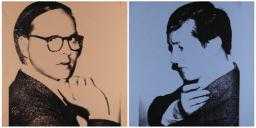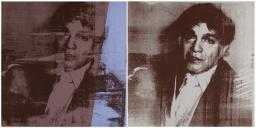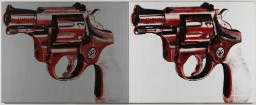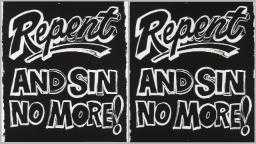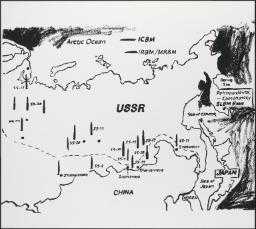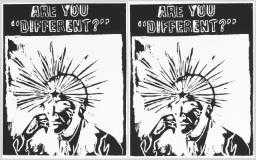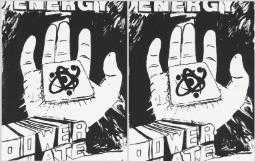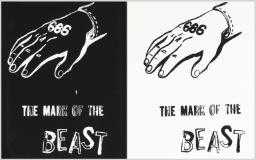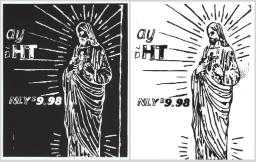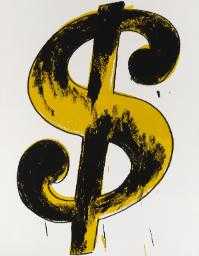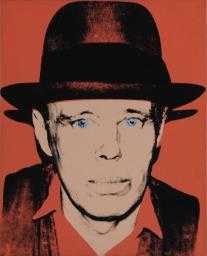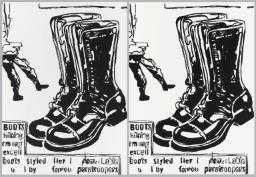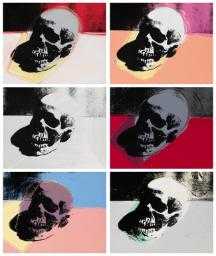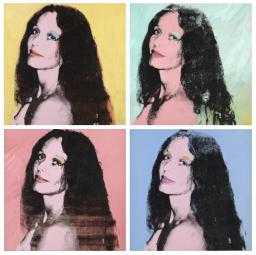
In Tate Modern
- Artist
- Andy Warhol 1928–1987
- Medium
- Acrylic paint and silkscreen on 2 canvases
- Dimensions
- Support, each: 1832 × 2037 × 33 mm
- Collection
- ARTIST ROOMS Tate and National Galleries of Scotland
- Acquisition
- ARTIST ROOMS Acquired jointly with the National Galleries of Scotland through The d'Offay Donation with assistance from the National Heritage Memorial Fund and the Art Fund 2008
- Reference
- AR00233
Summary
Hamburger is a duplicated image of an advertisement, silkscreened in black onto canvas with a white background. In this high contrast reproduction the original image has been simplified to the extent that most of the detail has been lost and only the black outline remains. The central line of text exclaims ‘HAMBURGER’ in capital letters, with the words ‘Wholesome’ and ‘Delicious’ in smaller text beneath, with no reference to a particular brand name. Warhol doubled the image to form a diptych, which has then been set within one frame to make a single work. The light coloured background and black ink mark a departure from the bold colours of Warhol’s earlier prints.
Hamburger is one of several works created by Warhol in the mid-1980s in which he revisited the forms and motifs of his work from the 1960s. This work was part of a series called Ads and Illustrations of which there are other examples in the ARTIST ROOMS collection (for instance Paratrooper Boots, Tate AR00588, Energy-Power, Tate AR00237, and Repent and Sin No More, Tate AR00234, all c.1985–6). The advertisements were primarily taken from newspapers, traced by hand and then printed onto canvas. As such they have a looser, graphic quality than the artist’s highly stylised photo-silkscreen works printed from Polaroid photographs. This particular silkscreen was reused multiple times. In other versions of Hamburger Warhol experimented with different colours for the background and the text, such as red printed on yellow. Despite these changes, however, he maintained the simple two-tone scheme throughout the series.
Warhol’s choice of subject matter speaks to the artist’s interest in Americana (objects that epitomise American culture). In a 1977 interview for the magazine High Times Warhol responded to the question, ‘What do you like to eat?’ with the remark, ‘Just plain food. Plain American food’ (quoted in O’Brien 1977, p.259). The hamburger in particular was a recurrent motif in Warhol’s work. For instance, in a short video from 1981 Warhol filmed himself eating a hamburger alone at a table, in silence, with an impassive expression. Despite its repeated use in the artist’s work, the meaning attached to the hamburger motif was often ambiguous. That Warhol chose to revisit this iconic subject in the Ads and Illustrations series is noteworthy. The other silkscreen prints from this series in the ARTIST ROOMS collection make direct references to war, spirituality and religion in Reagan-era America. Yet although Hamburger seems to offer a more anodyne subject matter, it might be interpreted within the context of the escalation of the Cold War and the ensuing public fears of the nuclear threat from the Soviet Union. Specifically, the lines radiating outwards from the centre of the image, together with the bulbous shape of the burger bun, visually refer to the outline of an atomic mushroom cloud. In this way Hamburger articulates both American optimism and Cold War anxiety. Curator Vincent Fremont has observed that this series of paintings not only echoes the politics of America in the 1980s, but also ‘continues to bluntly reflect the world we live in today’, with similar anxieties and concerns following us into the twenty-first century (Buchloh and Fremont 2002, p.18).
Further reading
Glenn O’Brien, ‘Interview: Andy Warhol’ (1977) in Kenneth Goldsmith (ed.), I’ll Be Your Mirror: The Selected Andy Warhol Interviews: 1962–1987, New York 2004, pp.233–64.
Benjamin Buchloh and Vincent Fremont, Andy Warhol: B&W Paintings, Ads and Illustrations 1985–1986, exhibition catalogue, Gagosian Gallery, New York and London 2002, reproduced p.19.
Frayda Feldman and Jörg Schellmann, Andy Warhol Prints: A Catalogue Raisonné 1962–1987, New York 2003, p.354, reproduced p.255.
Oliver Lurz
The University of Edinburgh
January 2012
The University of Edinburgh is a research partner of ARTIST ROOMS.
Does this text contain inaccurate information or language that you feel we should improve or change? We would like to hear from you.
Online caption
During the mid 1980s Warhol returned to the newspaper adverts that had informed his paintings of the early 1960s. He created a group of works called ‘Ad’s and Illustrations’ that differed from his photographic screenprints and highly stylised images of celebrities. They are mostly black and white and were created by tracing the original adverts by hand, which creates a looser, graphic quality. During the 1980s the U.S.A. was still in the depths of the Cold War. Within this context three themes emerge in these paintings: war, death and religion. This diptych, featuring the iconic American hamburger, is reminiscent of Warhol’s earlier screenprints of American popular culture. Yet it also resembles both a mushroom cloud (associated with nuclear explosions) and a glowing halo.
Explore
- emotions, concepts and ideas(16,416)
-
- formal qualities(12,454)
-
- repetition(391)
- food and drink(980)
-
- hamburger(1)
- lifestyle and culture(10,247)
-
- advertising(536)
- popular culture(61)
- inscriptions(6,664)
-
- title of work(308)
- word(280)
You might like
-
Andy Warhol Man Ray
1974 -
Andy Warhol Gilbert and George
1975 -
Andy Warhol Alexandre Iolas
1972 -
Andy Warhol Gun
1981 -
Andy Warhol Repent and Sin No More!
1985–6 -
Andy Warhol Map of Eastern U.S.S.R. Missile Bases
c.1985–6 -
Andy Warhol Are You Different?
c.1985–6 -
Andy Warhol Energy - Power
c.1985–6 -
Andy Warhol The Mark of the Beast
c.1985–6 -
Andy Warhol Christ $9.98 (negative and positive)
1985–6 -
Andy Warhol Dollar Sign
1981 -
Andy Warhol Portrait of Joseph Beuys
1980 -
Andy Warhol Paratrooper Boots
1985–6 -
Andy Warhol Skulls
1976 -
Andy Warhol Brooke Hayward
1973


